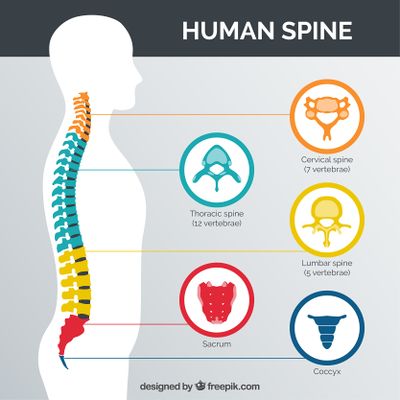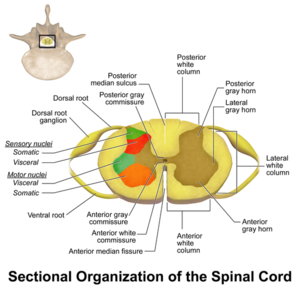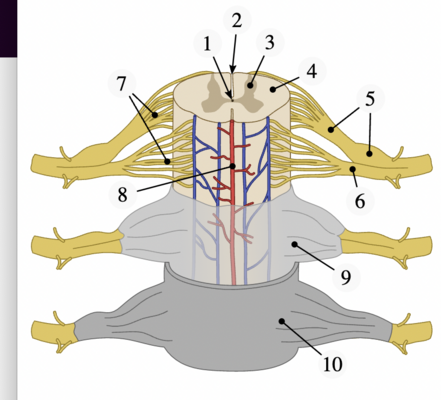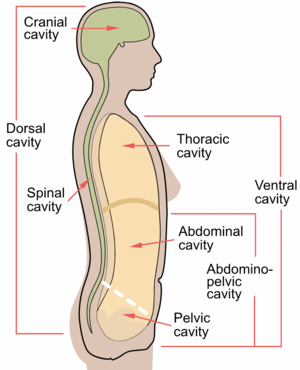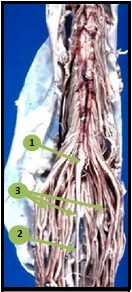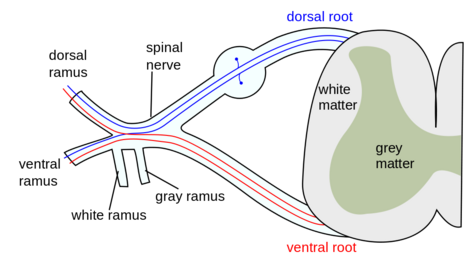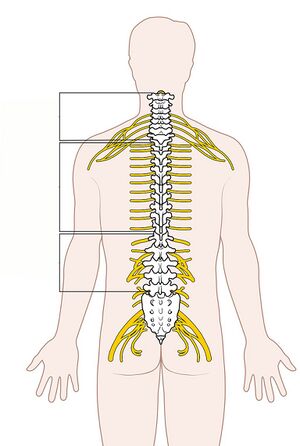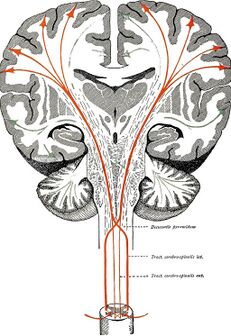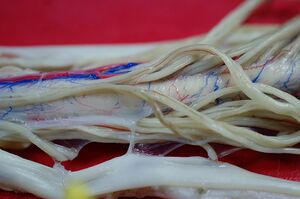Spinal cord anatomy: Difference between revisions
(internal links) |
No edit summary |
||
| (37 intermediate revisions by 8 users not shown) | |||
| Line 3: | Line 3: | ||
'''Top Contributors''' - {{Special:Contributors/{{FULLPAGENAME}}}} | '''Top Contributors''' - {{Special:Contributors/{{FULLPAGENAME}}}} | ||
</div | </div> | ||
== Introduction == | == Introduction == | ||
[[File:Spinal cord length.gif|right|frameless| | [[File:Spinal cord length.gif|right|frameless|400x400px|alt=]] | ||
The spinal cord is part of the [[Introduction to Neuroanatomy|central nervous system]] and consists of a tightly packed column of nerve tissue that extends downwards from the [[brainstem]] through the central column of the spine. It is a relatively small bundle of tissue (weighing 35g and just about 1cm in diameter) but is crucial in facilitating our [[Activities of Daily Living|daily activities]]. | |||
The spinal cord carries nerve signals from the [[Brain Anatomy|brain]] to other parts of the body (importantly the [[Muscle|muscles]] we use to move) and receives sensory input from the body, partially processes it, and then transmits that information to the brain. | |||
Along with its role in relaying motor and sensory signals between the brain and periphery, the spinal cord also provides separate neural circuits for many of our [[reflexes]]. Some reflexes eg the knee-jerk are built into the nervous system and bypass the brain, while others can be learned over time. | |||
== Spinal Cord: External == | |||
[[File:42282-O3EL6G.jpg|Spinal Column <ref name=":3">Designed by Freepik at http://www.freepik.com</ref>|400x400px|frameless|alt=|right]] | |||
Externally, the spinal cord is protected by 33 vertebrae, which sit between a semi-rigid [[intervertebral disc]], which provide a level of flexibility to the vertebral column. Its flexibility is greatest in the [[Cervical Anatomy|cervical]] region and lowest in the [[Thoracic Anatomy|thoracic]] region. The spinal cord (similar to the brain) is protected by three layers of [[Meningitis|meninges]] (membranes). The spinal cord extends from the foramen magnum to the lowest border of the first lumbar vertebra. It is enlarged at two sites, the cervical and lumbar region. | |||
The vertebrae (in adults) are arranged in five regions, which provide support and protection for the spinal cord'''.''' It consists of seven [[Cervical Vertebrae]], twelve [[Thoracic Vertebrae]], five [[Lumbar Vertebrae]], five Sacral (fused in adults to form the [[sacrum]]) and four Coccygeal Vertebrae (fused to form the [[Coccyx Fractures|coccyx]]).<ref name=":2">Rohkamm Reinhard. Color Atlas of Neurology. Thieme; 2014 Sep 2.</ref> | |||
== Spinal Cord: Internal == | |||
[[Image:Spinal Cord Sectional Anatomy.png|300x300px|Spinal Cord Sectional Anatomy <ref>[http://blausen.com/?Topic=360 Spinal Cord]. ''Blausen Medical''. Retrieved on 26 January 2016.</ref>|right|frameless|alt=]]Inside, the spinal cord consists of grey matter and white matter. | |||
# The grey matter takes on the shape of a butterfly, with four 'wings' called horns: The horns in the front contain [[Motor Neurone|motor neurons]]; the horns in the back contain sensory neurons which carry sensory information. | |||
# The spinal cord grey matter is surrounded by a column of white matter, containing [[axons]] that allow different parts of the spinal cord to communicate smoothly, with signals passing upwards and downwards conveying eg [[sensation]] and motor signals. | |||
Entry and Exit | |||
* Sensory Nerve Fibres enter the Spinal Cord via the Posterior (Dorsal) Root. The cell bodies for these neurons are situated in the Dorsal Root Ganglia. | |||
* Motor and Preganglionic Autonomic Fibres exit via the Anterior (Ventral) Root. | |||
[[ | Below is a good image of the Spinal cord,labelled[[File:Spinal cord labelled.png|right|frameless|441x441px|alt=]] | ||
# central canal | |||
# posterior median sulcus | |||
# gray matter | |||
# white matter | |||
# dorsal root + dorsal root ganglion | |||
# ventral root | |||
# ventral and dorsal nerve rootlets | |||
# anterior spinal artery | |||
# arachnoid mater | |||
# dura mater | |||
== Spinal Canal == | == Spinal Canal == | ||
Formed by the vertebral foramina of the vertebral bodies the spinal canal [bound anteriorly by the vertebral bodies and posteriorly by the laminae (vertebral arches)] with reinforcement at the walls through the intervertebral disks and the anterior and posterior longitudinal ligaments. The diameter varies from 12 to 22 mm in the [[Cervical Anatomy|cervical]] region and from 22 to 25 mm in the lumbar region. | [[File:Spinal canal.png|thumb|Spinal cord sits in the spinal cavity]] | ||
Formed by the vertebral foramina of the vertebral bodies the spinal canal [bound anteriorly by the vertebral bodies and posteriorly by the laminae (vertebral arches)] with reinforcement at the walls through the intervertebral disks and the [[Anterior longitudinal ligament|anterior]] and [[Posterior longitudinal ligament|posterior longitudinal ligaments]]. The diameter varies from 12 to 22 mm in the [[Cervical Anatomy|cervical]] region and from 22 to 25 mm in the lumbar region. | |||
Contains: | Contains: | ||
* Spinal cord | * Spinal cord | ||
* Meninges | * Meninges | ||
* Blood vessels | *[[Cardiovascular System|Blood vessels]] | ||
* Spinal nerve roots and surrounding fatty and connective tissues. <ref name=":0">Moore KL, Agur AM, Dalley AF. Essential Clinical Anatomy. Philadelphia: Lippincott Williams & Wilkins; 2002 Mar.</ref><ref name=":2" /> | *[[Spinal Nerves|Spinal nerve]] roots and surrounding fatty and [[Connective Tissue Disorders|connective]] tissues. <ref name=":0">Moore KL, Agur AM, Dalley AF. Essential Clinical Anatomy. Philadelphia: Lippincott Williams & Wilkins; 2002 Mar.</ref><ref name=":2" /> | ||
== Spinal Cord == | == Spinal Cord == | ||
The spinal cord is the major conduit and [[Reflexes|reflex]] centre between the peripheral nerves and the brain and transmits motor information from the brain to the muscles, tissues and organs, and sensory information from these areas back to the brain. <ref name=": | [[File:Cauda equina.jpeg|thumb|1.Conus medullaris 2. Filum terminale 3. Cauda Equina]] | ||
The spinal cord is the major conduit and [[Reflexes|reflex]] centre between the peripheral nerves and the brain and transmits motor information from the brain to the muscles, tissues and organs, and sensory information from these areas back to the brain. <ref name=":1">Francisco de Assis Aquino Gondim et al., Topographic and Functional Anatomy of the Spinal Cord, Medshape, 2015</ref> It is, in an adult, approximately 45 cm long, cylindrical and slightly flattened anteriorly and posteriorly.<ref name=":0" />. | |||
Its upper end is continuous with the medulla, the transition is defined to occur just above the level of exit of the first pair of cervical nerves. | |||
Its tapering lower end, the conus medullaris, terminates at the level of the L3 vertebra in neonates, and at the level of the L1-2 intervertebral disk in adults. It then becomes the cauda equina<ref name=":3" /> | |||
The cauda equina | |||
* Is the name given to the roots of the spinal nerves that extend beyond the termination of the spinal cord at the first lumbar vertebra in the form of a bundle of filaments within the spinal canal resembling a horse's tail<ref>Merriam webster Cauda equina Available:https://www.merriam-webster.com/medical/cauda%20equina (accessed 29.4.2022)</ref> | |||
* Has approximately 10 fiber pairs at its base: 3 to 5 lumbar fiber pairs; 5 sacral fiber pairs, and 1 coccygeal nerve. | |||
* Primary function of the cauda equina is to send and receive messages between the lower limbs and the pelvic organs, which consist of the bladder, the rectum, and the internal genital organs<ref>Healthline Cauda equina Available: https://www.healthline.com/human-body-maps/cauda-equina#1<nowiki/>(accessed 29.4.2022)</ref>. | |||
== Spinal Nerves == | |||
== Spinal | [[File:Spinal nerve.png|thumb|472x472px|Spinal Nerve]]The term spinal nerve generally refers to a mixed spinal nerve that carries motor, sensory, and autonomic signals between the spinal cord and the body. | ||
Humans have 31 left–right pairs of spinal nerves, each roughly corresponding to a segment of the vertebral column. There are eight cervical*, twelve thoracic, five lumbar, five sacral and one coccygeal. | |||
The spinal nerves are relatively large nerves that are formed by the merging of two nerve roots: a sensory nerve root and a motor nerve root. | |||
[[File:Spinal Cord.jpeg|thumb|Spinal cord and spinal nerves]] | |||
Sensory nerve roots emerge from the back of the spinal cord and the motor nerve roots from the front of the spinal cord. As they join, they form the spinal nerves on the sides of the spinal cord<ref>Very well health Spinal Nerves Available:https://www.verywellhealth.com/spinal-nerves-anatomy-4682599 (accessed 29.4.2022)</ref>. | |||
The anterior and posterior roots join to form two spinal nerves, one on either side of the spine, which then exit the vertebral canal through the intervertebral foramina. Once outside the intervertebral foramina they form peripheral nerves. <ref name=":2" /> | |||
The | |||
= | <nowiki>*</nowiki>While there are eight pairs of cervical spinal nerves there are only seven cervical vertebrae. This disparity occurs because the first pair of cervical spinal nerves exits ''above'' the first cervical vertebra just below the skull. However, the eighth pair of cervical spinal nerves exits ''below'' the last cervical vertebra.* <ref name=":0" /> | ||
== | == Spinal Cord Muscle Innervation == | ||
For each spinal cord level and muscles innervated see [[Spinal Cord Muscle Innervation]] | |||
=== | === Spinal Motorneurons === | ||
Alpha and Gamma [[Motor Neurone|motor neurons]] are both found in the anterior (ventral) horn. | |||
# Alpha motor neurons are the largest motor neurons in the nervous system and innervate skeletal muscle. | |||
# Gamma Motorneurons innervate intrafusal muscle fibres of the [[Muscle spindles|muscle spindle]]. | |||
Motor neurons are arranged somatotopically across the anterior horn. The more medially placed motor neurons innervate proximal muscles while laterally placed motor neurons innervate distal muscles. <ref name=":0" /><ref name=":2" /> | |||
== | == Associated Pathways == | ||
[[File:Brain and spinal cord tracts.jpeg|thumb|336x336px|Brain and spinal cord tracts]] | |||
The central nervous system uses ascending and descending pathways to communicate with the external environment. See [[Central Nervous System Pathways]]. | |||
== Blood Supply == | |||
The majority of the spinal cord [[Blood Physiology|blood]] supply is provided by the segmental spinal arteries, with further supply coming from the [[Vertebral Artery|vertebral arteries]] via a single anterior spinal artery and paired posterior spinal arteries. The segmental and spinal arteries are linked by numerous anastomoses. <ref name=":0" /><ref name=":2" /> | |||
'''Segmental Arteries:''' The segmental [[arteries]] give off radicular branches, cervical and thoracolumbar, which enter the intervertebral foramen and supply the anterior and posterior roots and spinal ganglion of the corresponding level. The spinal cord itself is supplied by unpaired medullary arteries that originate from segmental arteries. <ref name=":0" /><ref name=":2" /> | |||
'''Spinal Arteries:''' The spinal arteries, arising from the vertebral artery, run longitudinally down the spinal cord. The unpaired anterior spinal artery lies in the anterior median fissure of the spinal cord and extends from the level of the lower brainstem to the tip of the conus medullaris, with the diameter steadily increasing below the T2 level. It supplies the ventral medial surface of the medulla and anterior 2/3 of the spinal cord. The paired posterior spinal arteries supply the dorsal columns and the all but the base of the dorsal horns bilaterally. There are reinforcing branches from other arteries along the length of the cord and numerous anastomoses of the spinal arteries produce a vasocorona around the spinal cord. If occlusion occurs, it is normally of the anterior spinal artery, producing loss of power and spinothalamic sensory deficit, but dorsal column sensory capabilities are maintained. <ref name=":0" /><ref name=":2" />[[File:Spinal cord posterior.jpeg|thumb|Posterior spinal cord Great Posterior Radiculomedullary Artery]]'''Spinal Veins:''' Blood from within the spinal cord travels through the intramedullary [[veins]], to the anterior and posterior spinal veins, which form a reticulated network in the pia mater around the circumference of the cord throughout its length. The anterior two-thirds of the gray matter drain via the anterior spinal vein, while the posterior and lateral spinal veins drain the rest of the spinal cord. These vessels empty by way of the radicular veins into the external and internal vertebral venous plexuses, groups of valveless veins that extend from the coccyx to the base of the skull. The vertebral and deep cervical veins drain venous blood from the cervical spine into the superior vena cava; the posterior intercostal and lumbar veins drain venous supply from the thoracic and lumbar spine into the azygos and hemiazygos veins; and the median and lateral sacral veins drain venous supply from the sacrum into the common iliac vein. <ref name=":0" /><ref name=":2" /> | |||
== References == | == References == | ||
<references /> | <references /> | ||
| Line 1,548: | Line 102: | ||
[[Category:Spinal Cord Injuries]] | [[Category:Spinal Cord Injuries]] | ||
[[Category:Anatomy]] | [[Category:Anatomy]] | ||
[[Category:Spinal Cord - Anatomy]] | [[Category:Spinal Cord - Anatomy]] | ||
Latest revision as of 18:31, 17 January 2023
Original Editor - Naomi O'Reilly
Top Contributors - Naomi O'Reilly, Lucinda hampton, Kim Jackson, Nikhil Benhur Abburi, Vidya Acharya, Aminat Abolade, Admin, Tarina van der Stockt, Jess Bell, Ewa Jaraczewska and Rucha Gadgil
Introduction[edit | edit source]
The spinal cord is part of the central nervous system and consists of a tightly packed column of nerve tissue that extends downwards from the brainstem through the central column of the spine. It is a relatively small bundle of tissue (weighing 35g and just about 1cm in diameter) but is crucial in facilitating our daily activities.
The spinal cord carries nerve signals from the brain to other parts of the body (importantly the muscles we use to move) and receives sensory input from the body, partially processes it, and then transmits that information to the brain.
Along with its role in relaying motor and sensory signals between the brain and periphery, the spinal cord also provides separate neural circuits for many of our reflexes. Some reflexes eg the knee-jerk are built into the nervous system and bypass the brain, while others can be learned over time.
Spinal Cord: External[edit | edit source]
Externally, the spinal cord is protected by 33 vertebrae, which sit between a semi-rigid intervertebral disc, which provide a level of flexibility to the vertebral column. Its flexibility is greatest in the cervical region and lowest in the thoracic region. The spinal cord (similar to the brain) is protected by three layers of meninges (membranes). The spinal cord extends from the foramen magnum to the lowest border of the first lumbar vertebra. It is enlarged at two sites, the cervical and lumbar region.
The vertebrae (in adults) are arranged in five regions, which provide support and protection for the spinal cord. It consists of seven Cervical Vertebrae, twelve Thoracic Vertebrae, five Lumbar Vertebrae, five Sacral (fused in adults to form the sacrum) and four Coccygeal Vertebrae (fused to form the coccyx).[2]
Spinal Cord: Internal[edit | edit source]
Inside, the spinal cord consists of grey matter and white matter.
- The grey matter takes on the shape of a butterfly, with four 'wings' called horns: The horns in the front contain motor neurons; the horns in the back contain sensory neurons which carry sensory information.
- The spinal cord grey matter is surrounded by a column of white matter, containing axons that allow different parts of the spinal cord to communicate smoothly, with signals passing upwards and downwards conveying eg sensation and motor signals.
Entry and Exit
- Sensory Nerve Fibres enter the Spinal Cord via the Posterior (Dorsal) Root. The cell bodies for these neurons are situated in the Dorsal Root Ganglia.
- Motor and Preganglionic Autonomic Fibres exit via the Anterior (Ventral) Root.
Below is a good image of the Spinal cord,labelled
- central canal
- posterior median sulcus
- gray matter
- white matter
- dorsal root + dorsal root ganglion
- ventral root
- ventral and dorsal nerve rootlets
- anterior spinal artery
- arachnoid mater
- dura mater
Spinal Canal[edit | edit source]
Formed by the vertebral foramina of the vertebral bodies the spinal canal [bound anteriorly by the vertebral bodies and posteriorly by the laminae (vertebral arches)] with reinforcement at the walls through the intervertebral disks and the anterior and posterior longitudinal ligaments. The diameter varies from 12 to 22 mm in the cervical region and from 22 to 25 mm in the lumbar region.
Contains:
- Spinal cord
- Meninges
- Blood vessels
- Spinal nerve roots and surrounding fatty and connective tissues. [4][2]
Spinal Cord[edit | edit source]
The spinal cord is the major conduit and reflex centre between the peripheral nerves and the brain and transmits motor information from the brain to the muscles, tissues and organs, and sensory information from these areas back to the brain. [5] It is, in an adult, approximately 45 cm long, cylindrical and slightly flattened anteriorly and posteriorly.[4].
Its upper end is continuous with the medulla, the transition is defined to occur just above the level of exit of the first pair of cervical nerves.
Its tapering lower end, the conus medullaris, terminates at the level of the L3 vertebra in neonates, and at the level of the L1-2 intervertebral disk in adults. It then becomes the cauda equina[1]
The cauda equina
- Is the name given to the roots of the spinal nerves that extend beyond the termination of the spinal cord at the first lumbar vertebra in the form of a bundle of filaments within the spinal canal resembling a horse's tail[6]
- Has approximately 10 fiber pairs at its base: 3 to 5 lumbar fiber pairs; 5 sacral fiber pairs, and 1 coccygeal nerve.
- Primary function of the cauda equina is to send and receive messages between the lower limbs and the pelvic organs, which consist of the bladder, the rectum, and the internal genital organs[7].
Spinal Nerves[edit | edit source]
The term spinal nerve generally refers to a mixed spinal nerve that carries motor, sensory, and autonomic signals between the spinal cord and the body.
Humans have 31 left–right pairs of spinal nerves, each roughly corresponding to a segment of the vertebral column. There are eight cervical*, twelve thoracic, five lumbar, five sacral and one coccygeal.
The spinal nerves are relatively large nerves that are formed by the merging of two nerve roots: a sensory nerve root and a motor nerve root.
Sensory nerve roots emerge from the back of the spinal cord and the motor nerve roots from the front of the spinal cord. As they join, they form the spinal nerves on the sides of the spinal cord[8].
The anterior and posterior roots join to form two spinal nerves, one on either side of the spine, which then exit the vertebral canal through the intervertebral foramina. Once outside the intervertebral foramina they form peripheral nerves. [2]
*While there are eight pairs of cervical spinal nerves there are only seven cervical vertebrae. This disparity occurs because the first pair of cervical spinal nerves exits above the first cervical vertebra just below the skull. However, the eighth pair of cervical spinal nerves exits below the last cervical vertebra.* [4]
Spinal Cord Muscle Innervation[edit | edit source]
For each spinal cord level and muscles innervated see Spinal Cord Muscle Innervation
Spinal Motorneurons[edit | edit source]
Alpha and Gamma motor neurons are both found in the anterior (ventral) horn.
- Alpha motor neurons are the largest motor neurons in the nervous system and innervate skeletal muscle.
- Gamma Motorneurons innervate intrafusal muscle fibres of the muscle spindle.
Motor neurons are arranged somatotopically across the anterior horn. The more medially placed motor neurons innervate proximal muscles while laterally placed motor neurons innervate distal muscles. [4][2]
Associated Pathways[edit | edit source]
The central nervous system uses ascending and descending pathways to communicate with the external environment. See Central Nervous System Pathways.
Blood Supply[edit | edit source]
The majority of the spinal cord blood supply is provided by the segmental spinal arteries, with further supply coming from the vertebral arteries via a single anterior spinal artery and paired posterior spinal arteries. The segmental and spinal arteries are linked by numerous anastomoses. [4][2]
Segmental Arteries: The segmental arteries give off radicular branches, cervical and thoracolumbar, which enter the intervertebral foramen and supply the anterior and posterior roots and spinal ganglion of the corresponding level. The spinal cord itself is supplied by unpaired medullary arteries that originate from segmental arteries. [4][2]
Spinal Arteries: The spinal arteries, arising from the vertebral artery, run longitudinally down the spinal cord. The unpaired anterior spinal artery lies in the anterior median fissure of the spinal cord and extends from the level of the lower brainstem to the tip of the conus medullaris, with the diameter steadily increasing below the T2 level. It supplies the ventral medial surface of the medulla and anterior 2/3 of the spinal cord. The paired posterior spinal arteries supply the dorsal columns and the all but the base of the dorsal horns bilaterally. There are reinforcing branches from other arteries along the length of the cord and numerous anastomoses of the spinal arteries produce a vasocorona around the spinal cord. If occlusion occurs, it is normally of the anterior spinal artery, producing loss of power and spinothalamic sensory deficit, but dorsal column sensory capabilities are maintained. [4][2]
Spinal Veins: Blood from within the spinal cord travels through the intramedullary veins, to the anterior and posterior spinal veins, which form a reticulated network in the pia mater around the circumference of the cord throughout its length. The anterior two-thirds of the gray matter drain via the anterior spinal vein, while the posterior and lateral spinal veins drain the rest of the spinal cord. These vessels empty by way of the radicular veins into the external and internal vertebral venous plexuses, groups of valveless veins that extend from the coccyx to the base of the skull. The vertebral and deep cervical veins drain venous blood from the cervical spine into the superior vena cava; the posterior intercostal and lumbar veins drain venous supply from the thoracic and lumbar spine into the azygos and hemiazygos veins; and the median and lateral sacral veins drain venous supply from the sacrum into the common iliac vein. [4][2]
References[edit | edit source]
- ↑ 1.0 1.1 Designed by Freepik at http://www.freepik.com
- ↑ 2.0 2.1 2.2 2.3 2.4 2.5 2.6 2.7 Rohkamm Reinhard. Color Atlas of Neurology. Thieme; 2014 Sep 2.
- ↑ Spinal Cord. Blausen Medical. Retrieved on 26 January 2016.
- ↑ 4.0 4.1 4.2 4.3 4.4 4.5 4.6 4.7 Moore KL, Agur AM, Dalley AF. Essential Clinical Anatomy. Philadelphia: Lippincott Williams & Wilkins; 2002 Mar.
- ↑ Francisco de Assis Aquino Gondim et al., Topographic and Functional Anatomy of the Spinal Cord, Medshape, 2015
- ↑ Merriam webster Cauda equina Available:https://www.merriam-webster.com/medical/cauda%20equina (accessed 29.4.2022)
- ↑ Healthline Cauda equina Available: https://www.healthline.com/human-body-maps/cauda-equina#1(accessed 29.4.2022)
- ↑ Very well health Spinal Nerves Available:https://www.verywellhealth.com/spinal-nerves-anatomy-4682599 (accessed 29.4.2022)
